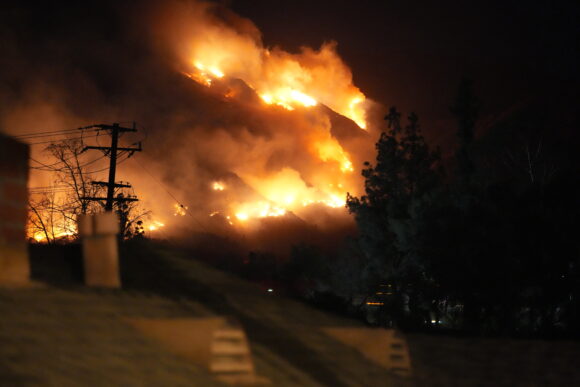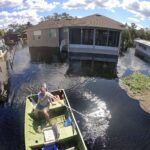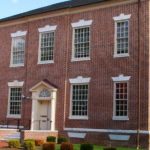PART TWO OF A TWO-PART SERIES
In this second article in a two-part series, Journalist Russ Banham endeavors to better understand the factors behind the devastating fires in Los Angeles County and the roles that public officials, fire suppression personnel, insurance regulators, insurance carriers, and homeowners can play to forge a safer future.
Read Part 1, “An Insurance Journalist’s Perspective on Southern California’s Wildfires,” in Insurance Journal’s April 7, 2025, print issue or visit www.CarrierManagement.com.
Last weekend, my wife, Jenny, and I drove three miles from our home to see firsthand the widespread devastation caused by the Eaton Fire in Altadena.
I had been determined not to visit the scene of such grief and despair out of respect for others’ privacy. But after writing about our four-day mandatory evacuation and plans to invest in fortifying our house against the next wildfire, a fact-finding mission was in order. I needed to ascertain why some houses survived the annihilation.
It was a splendid day with mostly blue skies as Jenny drove her car slowly through the charred remains of the neighborhood. Most of the hazardous debris had been removed by the U.S. Army Corps of Engineers. What remained took on a solemn quality.
Carbonized bikes and cars littered many lots. Fireplace chimneys poked out of flattened rows of houses like tombstones. Springtime bouquets of wild yellow sunflowers called California Goldfield bordered blackened trees wrapped in strips of colored tape for removal. Former mansions were evident by their grand staircases, beckoning guests to nothingness.
“It’s like the ruins of an ancient city,” whispered Jenny, an art teacher at an elementary school in the San Fernando Valley.
Now and then, a house sprouted serenely from the wreckage. Jenny stopped the car, and I studied them. All were built with noncombustible materials like brick, stone, and stucco. I do not know if other houses, now gone, were made of similar materials, but the information was encouraging.
I was in my quiet reporter mode taking notes while Jenny talked about the memories the houses held–the kids’ drawings, photo albums, precious heirlooms, and holiday parties. “I need to go home now,” she said.
Living in California
We live in the same wildland-urban interface in between the San Gabriel Mountains and the built environment in La Canada Flintridge as the people of Altadena, in a 75-year-old house on a block of similar vintage structures.
As I wrote in my previous article of this series, Jenny and I have decided to stay put in spite of the wildfire risks. We love the woodsy environs, hiking in local hills, proximity to all Los Angeles offers, and our neighbors.
We took out a HELOC to make our house as fire resistant as possible, with the aim of receiving the IBHS Wildfire Prepared Home program designation. We’re also hopeful to exit the California FAIR Plan at some point. Capital has been earmarked for double-paned, tempered glass windows framed in noncombustible materials; fire-resistant aluminum fencing and front gate; fire-resistant steel barriers between our house and flanking structures; and Class A fire-rated intumescent paint as an alternative to expensive siding. I took care of relatively inexpensive improvements like clearing the vegetation surrounding our house and replacing the vents near the foundation, in the attic, and under the eaves.
Over the past month, I conducted a series of interviews to better understand the causes of wildfires, what is being done to reduce their severity and frequency in a sprawling county of foothills and mountains, and our chances of finding homeowners insurance in the private insurance market. The interviewees included the head of Los Angeles County’s forest management program, a veteran fire investigator, California’s former insurance commissioner, my independent insurance agent, and several neighbors.
I wanted to know:
- Why did the wildlands get so wild, what is being done to tame them, and will fire-suppression activities like prescribed burns and low-lying vegetation clearing expand?
- Since we know the ignition sources for many recent wildfires–sparking from power lines, fireworks, the burning of debris, fires set by homeless people, and arson–can the laws banning such activities be strengthened and vigorously enforced?
- What are the most effective ways for homeowners to fortify their properties against fire without breaking the bank?
- Will the insurance industry financially encourage homeowner wildfire mitigations that reduce the possibility of widespread destruction?
As I was doing the interview, California was in the process of releasing a series of updates to its Fire Hazard Severity Zone maps. The last batch, published by the California Department of Forestry and Fire Protection (Cal Fire) on March 24, added more than 440,000 acres to Los Angeles County’s fire hazard zones. Areas in the county with the highest fire hazard increased by 30%. Cal Fire is the state agency responsible for fire prevention, fire protection, and resource management on over 31 million acres of California’s wildlands.
Across California, 1.2 million acres are now categorized in the “very high” fire hazard zone, up from 860,000 acres a decade ago. Approximately 4.5 million acres are in a “high” or “moderate” hazard zone. Altogether, 3.7 million people live within the three zones statewide–an area twice the size of Delaware.
A Paradigm Shift
Several people I talked with believe that in the aftermath of the seven fires that raged simultaneously on Jan. 9 throughout Los Angeles County, residents have reached the breaking point and are demanding government actions that radically decrease wildfire ignition sources and the combustible fuel load of forests.
“Existential dread is a powerful force,” said my insurance agent, Azy Susman, owner of Susman Insurance Services Inc. “Most everyone in Los Angeles County knows someone directly affected by the recent wildfires. People living in urban areas a few miles from the foothills used to think they were protected. Now there’s obvious proof they’re not, due to the velocity and unpredictability of the Santa Ana winds carrying embers miles away.”
More than 100 of Azy’s clients lost their homes in the Eaton and Palisades fires. “The first time they called after the fires erupted, they were unbelievably calm. They were in shock, of course,” she said. “The second time, they talked about the typical insurance issues, the nitty gritty of what they had to fill out and when they would receive payment. The third time, they talked about the impact on their kids. That’s when the emotions spilled over.”
The overwhelming majority of Azy’s clients received a check from their insurance adjuster within days. “My clients and other agents’ clients were not battling with their insurance carriers, as the press reported. However, many homeowners in the FAIR Plan sadly have yet to receive their claim payments–a nightmare for them and agents trying to expedite the checks. In my office, it was all hands on deck.”
Her staff of 17 people worked at her office in Brentwood from 6 a.m. till 10 p.m. and through the weekend to do everything possible for policyholders during one of the worst weeks of their lives. “When clients told me they needed a place to live–no joke–I went on Zillow to help them search,” she said. “I’m a problem solver by nature.”
Captain Kevin Montoya, head of the Prescribed Fire Management Program at the Los Angeles County Fire Department (LACoFD), also senses change in the air. “There’s a paradigm shift underway since the big wildfires,” he told me. “Unlike the Paradise Fire, this disaster was close to home. People in LA County watched entire communities close to them burn to the ground. Events like these change perceptions of what can be done and what needs to be done.”
Captain Montoya is a 24-year veteran firefighter, paramedic, engineer, and fire crew supervisor. When not out responding to an incident, he is responsible for supervising the fuel loads in the county’s forests, analyzing potential fire behaviors, and managing prescribed fire activities. His office is fortuitously located at LACoFD’s Fire Camp 2 in La Canada Flintridge, where we reside. When I referred to him as Captain Montoya, he humbly asked me to call him Kevin.
During our one-hour conversation, we discussed hiking in the Angeles Forest abutting La Canada Flintridge and traded some of our favorite trails. He mentioned that a crew was set to thin the vegetation in the hills north of our home in the next week–a stroke of plain good luck. He also pointed out the monumental task before the forest management teams he leads.
“If you look at photographs of California in the late 19th century and compare them with photographs from today, there’s a dramatic difference. Back then, natural fires and small fires purposely started by Native Americans cleared out much of the understory and smaller trees, reducing the risk of fires climbing into the bigger trees,” he explained. “Due to the suppression of fires over the past 150 years, you literally ‘can’t see the forest for the trees.’ There’s so much material to burn, it climbs like a ladder into the tree canopy and takes off from there.”
To decrease this gargantuan fuel load, the budget of the Wildfire and Forest Resilience Action Plan has almost doubled in the past six years to $4 billion. The capital goes toward the work Kevin and his peers across California do–prescribed burns and the thinning out and removal of low-lying chapparal and other vegetation. Over the same period, the number of Cal Fire employees providing these services also nearly doubled from 5,829 to 10,741.
Despite the additional capital and personnel, Kevin is realistic about the chances of quickly overcoming 150 years of fire suppression. “The idea that we can turn around [the forests] in a meaningful way overnight is hindered by obstacles. Every time you touch the ground in a forest in California, you have to fill out and file an EIR [Environmental Impact Report]. If you’re starting from scratch, you’re looking at a thousand pages, depending on who owns the land–the state, federal government, or a private landowner. Often, you need to hire an expensive environmental consultant just to fill out and file the EIL.”
A 200-acre forest management project costs $200,000, he said. “That’s a pretty heavy lift in a world where the climate keeps getting hotter and drier. But we’re definitely moving in the right direction, continuously reducing the fuel load and changing the behavior of wildfires.”
To get a better grasp on the success of these activities, I perused Cal Fire’s Fuels Treatment Effectiveness Dashboard, launched two months before the Eaton and Palisades fire. As its name indicates, viewers can click on a recent fire incident to view treatment details like fuel breaks, vegetation mastication, and tree thinning to determine if the action produced a positive impact. In several random clicks, I was encouraged to see the prescribed treatments decreased the intensity and slowed the progress of the wildfires.
Not knowing much about EIRs, I discovered the regulations came into effect with the California Environmental Quality Act of 1970. The goal of the legislation was to inform the public about the environmental effects of proposed forestland projects. Given the enormous increase in large wildfires and burned acreage in the 55 years since the regulation was effected, perhaps the time has come to find a more pragmatic balance between environmental concerns and citizens’ safety and economic well-being. “It’s taken events like the Eaton fire to change the perception of what can be done and should be done within reason,” Kevin said.
Monitoring Ignition Sources
My interview with arson specialist Joe Toscano, a fire investigator for major global insurers and reinsurers the past 30 years, underscored the difficulties inherent in stopping human sources of wildfire ignition. “There’s not much that can be done to prevent an arsonist from committing an act of arson, but earlier detection would provide an opportunity for fire suppression professionals to respond in a timely manner,” Toscano said.
A step in the right direction is the use of satellites already equipped with sensors to monitor wildfire spread. “The sensors can detect thermal signatures attributable to incipient fires in areas like riverbeds, where homeless people start cooking fires or campfires for warmth,” he said, adding that drones equipped with similar sensors can provide the same surveillance.
The number of fires ignited by homeless people in Los Angeles has climbed steadily in recent years. Nearly 14,000 such fires were reported in 2023, nearly double the number in 2020, according to Los Angeles Fire Department data. Although fires in unpermitted areas are banned, advocates for unhoused people contend they should not be arrested for basic human needs but should instead be equipped with fire extinguishers and other fire suppression tools.
“My first inclination is to keep such bans intact and strictly enforce them, considering the consequences,” Toscano said.
The exact cause of the Eaton and Palisades fires is still under investigation, although lightning has been ruled out.
While a homeless encampment was found near the suspected ignition point in Altadena’s Eaton Canyon, other evidence points to a dormant transmission tower with a history of electricity arcing as sparking the fire. Southern California Edison (SCE), the utility serving much of the region, is investigating both possibilities and other potential causes. In 2024, 178 fires were sparked by SCE equipment, up from 105 in 2015, according to annual state reports filed by the utility.
A report by the California Office of Energy Infrastructure cited in a March 30 article in The Los Angeles Times indicated that SCE has “thousands of open work orders to fix equipment problems found in inspections.” The good news is the rising amount of SCE capital spent on insulated wires, tree trimming and equipment inspections. In 2024, the utility dedicated $1.9 billion to reducing the risk of a wildfire, up 29% from the prior year, the article stated.
Hope Springs Eternal
The interviewees gave me a modicum of hope that the wildfire intensity will moderate a bit in the years ahead, assuming public support for needed change does not wane. In a recent poll administered by The Los Angeles Times, 80% of voters in Los Angeles County said they back tougher building codes to make homes more fire-resistant, even if it increases costs. Residents also said they are willing to pay higher taxes to boost funding for fire protection agencies.
Jenny and I share these opinions and are optimistic our wildfire risk mitigations will protect our house. That’s a bold declaration, but we are not alone in making it.
When my first article on the wildfires was published and featured on LinkedIn, several people I’d interviewed in the past as well as complete strangers reached out in support of our decision. Among them was Art Fliegelman, senior financial analyst, Office of Financial Research, at the U.S. Treasury Department.
“You are totally correct that mitigation is the only real viable solution. Without that, it is just rolling dice until the next event occurs,” Fliegelman emailed me. “Hopefully your changes will do the job. … Unlike a hurricane or flood, the risk of a fire depends a lot on what neighbors have or have not done. I have confidence LA will come back, but it depends upon people making the right choices and not repeating past mistakes. … It sounds like you are doing a lot of the right things.”
Fliegelman’s comment about the need to involve neighbors in protecting a community against wildfires struck home. We’ve had several such conversations. The families whose houses flank ours are participating in the cost of building fire-resistant steel barriers between our homes. My neighbor across the street, featured in the previous article as Catherine for her privacy, was extremely helpful in passing on the names of local contractors. (Kevin Kochar at Mulholland Brand gave me a tutorial on the fire-resistance differences in different grades of steel, aluminum, and vinyl gates that greatly assisted our decision-making.)
Catherine also weighed in on the recent decision that Pacific Palisades made to bury utility lines underground as the neighborhood rebuilds–a remedy every county in a high-risk hazard area should pursue, she said. “When they were installing the sewer system a decade ago in La Canada Flintridge and had all the roads torn up, several residents got together and urged the City Council to put the electric [lines] underground at the same time,” Catherine informed me. “They should have been more forward-thinking, but they’re a group of five people running a city part-time.”
The last person I interviewed was Dave Jones, the former state insurance commissioner and the director of the Climate Risk Initiative at the UC Berkeley School of Law. I wanted to know if the investments Jenny and I were making would provide the means to exit the California FAIR Plan. While Jones extolled our efforts, he explained that the exorbitant cost of the recent wildfires to insurers financially backing the plan make it unlikely for the time being.
Recent estimates indicate the FAIR Plan expects to incur over $4 billion in losses.
Another impediment is regulatory. “Policyholders in the FAIR Plan are not rated for the investments they’ve made in property, community, and landscape scale mitigation,” Jones explained. “I and others have written to the insurance department to make this necessary change.”
Until that occurs–if it happens at all–we and the 450,000 other Californians compelled to buy homeowners insurance from the FAIR Plan are looking at premium increases of 40% to 50% this year, possibly even more. I asked my insurance agent if she thought that market stability was forthcoming.
“Do I think State Farm will insure 85% of high fire hazard areas over the next few years as stipulated by the state’s new insurance regulation? No, not in their dire financial straits,” Azy said. “But carriers like Travelers, Safeco, and Mercury appear to be interested. The premium will be higher, but at least it’s a way for people to leave the FAIR Plan, eventually. And if Mercury or Travelers agree to insure your and Jenny’s home, there’s a good chance you’ll get discounts for hardening your premises against wildfire damage.”
There’s an old saying attributed to Roman playwright Titus Maccius Plautus, “You have to spend money to make money.” It would be great to say goodbye to the FAIR Plan someday, but more important to us and our neighbors is what Jenny latched onto during our pilgrimage to Altadena: the preservation of our memory- filled homes.
This article was first published in Carrier Management (www.carriermanagement.com) in early April 2025, a sister publication to Insurance Journal. In Part One of this series, Banham wrote about his personal experience living through the Eaton Fire on Jan. 9 and his and his wife’s endeavor to manage their future risk of wildfires by fortifying their home.
Was this article valuable?
Here are more articles you may enjoy.



 Trump Administration Turning to Private Firms in Cyber Offensive
Trump Administration Turning to Private Firms in Cyber Offensive  US House Bill Aims to End Private Flood Insurance Coverage Penalty
US House Bill Aims to End Private Flood Insurance Coverage Penalty  Insurance Industry ‘Megadeals’ Dominate 2025, Says PwC
Insurance Industry ‘Megadeals’ Dominate 2025, Says PwC  Insurance Covers Settlement Paid by Stocks Instead of Money: Delaware High Court
Insurance Covers Settlement Paid by Stocks Instead of Money: Delaware High Court 


